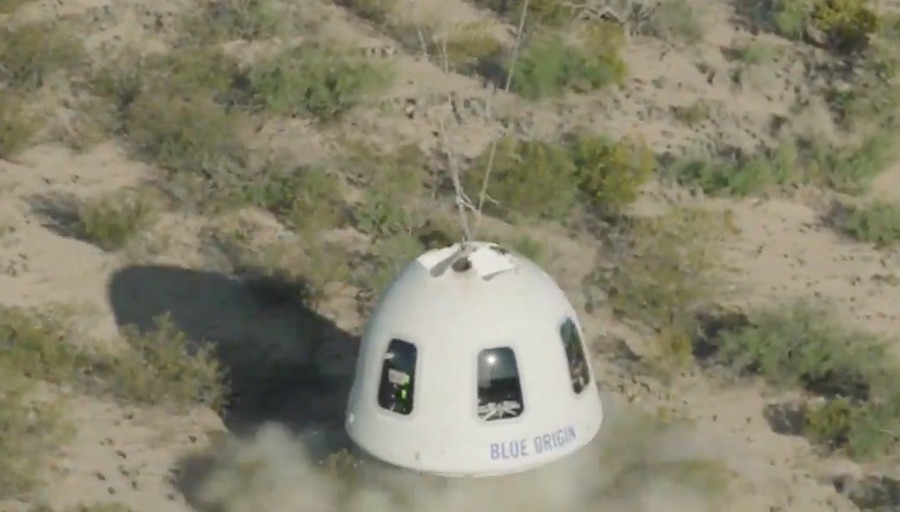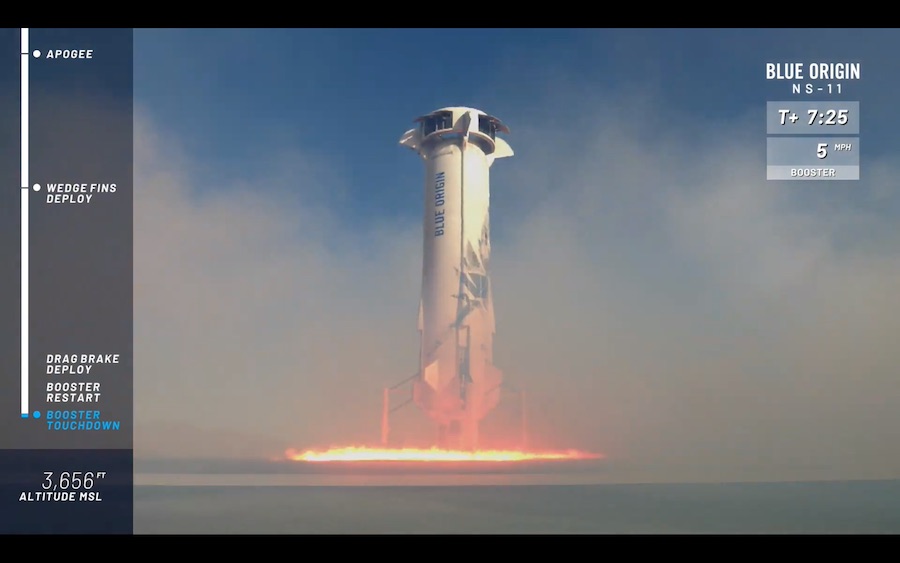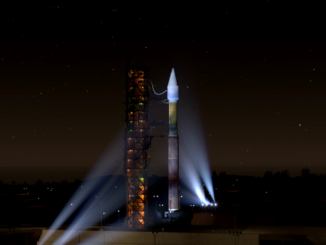
Taking another step toward flying space tourists to the edge of space, Jeff Bezos’s space company Blue Origin again flew its New Shepard suborbital booster Thursday with a package of microgravity research experiments.
The single-stage rocket took off from Blue Origin’s privately-operated launch site north of Van Horn, Texas, at 9:35 a.m. EDT (8:35 a.m. CDT; 1335 GMT).
Named for Mercury astronaut Alan Shepard, the rocket climbed into a clear sky powered by a hydrogen-fueled BE-3 main engine, which accelerated the vehicle to a speed of more than 2,200 mph (3,540 kilometers per hour) in less than two-and-a-half minutes.
After shutdown of the New Shepard’s main engine, a pressurized crew capsule on top of the rocket separated as the vehicles coasted to a maximum altitude of more than 346,000 feet, or about 105.5 kilometers, according to preliminary flight data.
A batch of 38 microgravity research payloads, including nine sponsored by NASA, were stowed aboard the capsule as it experienced about three-to-four minutes of weightlessness as the suborbital spacecraft arced through the apogee, or high point, of its trajectory and began falling back to Earth.
The New Shepard booster deployed air brakes before reigniting its throttleable BE-3 engine to slow down for a vertical touchdown on four landing legs about 2 miles (3 kilometers) from its launch site at Blue Origin’s sprawling West Texas facility.
Less than three minutes later, the capsule landed with the aid of three parachutes and retro-rockets to complete Blue Origin’s 11th suborbital flight since April 2015.

Blue Origin has flown three versions of its reusable New Shepard rocket. The first rocket was lost in a crash on landing in 2015, and the second unit flew five times before retirement. A third New Shepard vehicle, which flew Thursday, has completed five successful missions.
Blue Origin delivered a fourth New Shepard propulsion module to the West Texas test site late last year from the company’s factory in Kent, Washington. Officials said the fourth iteration of the New Shepard is the rocket that will carry people.
Blue Origin has not publicly disclosed when the latest New Shepard vehicle will debut, or which flight will be the first include human passengers.
Ariane Cornell, Blue Origin’s head of astronaut strategy and sales, said that Thursday’s launch and landing — a mission designated New Shepard 11, or NS-11 — moves the company “one step closer” to flying human passengers.
“Over the next couple of months, toward the end of this year, we are going to be flying humans on top of this rocket,” said Cornell, who hosted Blue Origin’s live webcast of Thursday’s flight.
The crew capsule launched by the New Shepard booster will have six seats, each with its own window to give passengers expansive views during flight.
The New Shepard is a stepping stone to Blue Origin’s larger ambitions, which include the development of a heavy-lift orbital-class rocket named the New Glenn. The inaugural launch of the New Glenn rocket from Cape Canaveral is scheduled for 2021.
Blue Origin’s chief competitor in the commercial suborbital spaceflight market is Virgin Galactic, founded by Richard Branson.
Virgin Galactic’s suborbital rocket plane, known as SpaceShipTwo, has completed two flights above an altitude of 50 miles (80 kilometers), both with people on-board.
The Federal Aviation Administration has awarded commercial astronaut wings to Rick Sturckow, Mark Stucky, Dave Mackay, Mike Masucci and Beth Moses, the five Virgin Galactic employees who flew on the first two SpaceShipTwo flights to the edge of space. Like the U.S. Air Force and NASA, the FAA awards astronauts wings to individuals who fly above an altitude of 50 miles.
The SpaceShipTwo vehicle is dropped from a carrier jet high in the atmosphere, then fires a rocket motor to climb to its peak altitude. On commercial space tourist flights, Virgin Galactic expects SpaceShipTwo to reach at least 50 miles, similar to the height achieved on the craft’s two most recent suborbital test flights in December and February.
Blue Origin says its New Shepard vehicle, which uses a much different flight profile, is designed to fly above the 62-mile-high (100-kilometer) Kármán line, the internationally-recognized boundary of space.
While Virgin Galactic has a roster of hundreds of would-be space tourists who have paid deposits for the $250,000 ticket to ride on SpaceShipTwo. Blue Origin has not announced a ticket price yet.
Email the author.
Follow Stephen Clark on Twitter: @StephenClark1.



